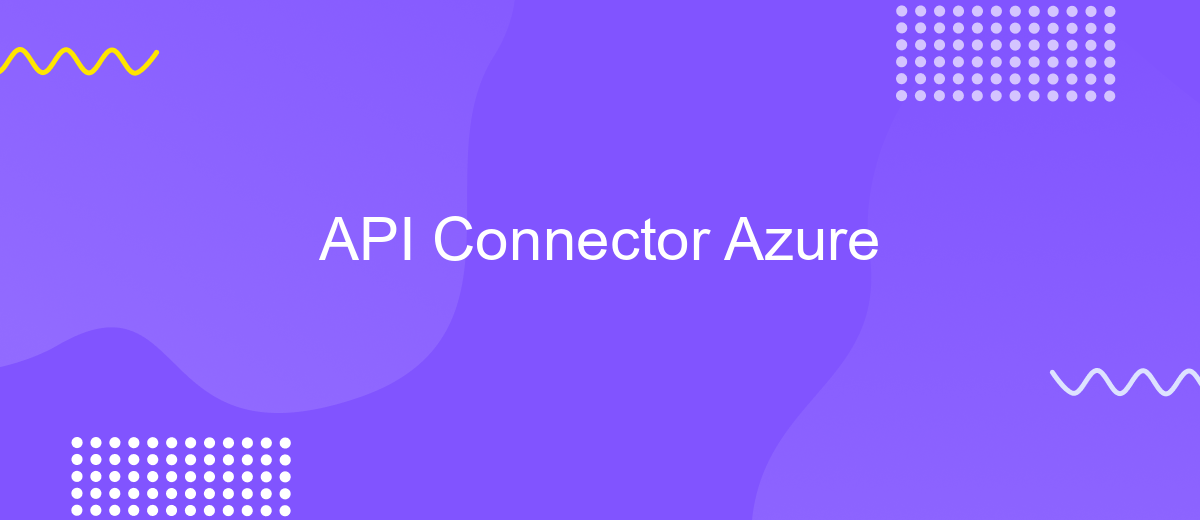API Connector Azure
Azure API Connector is a powerful tool that simplifies the integration of various applications and services within the Azure ecosystem. By providing seamless connectivity and streamlined communication between disparate systems, it enables businesses to enhance their workflows and automate processes efficiently. With Azure API Connector, developers can easily manage APIs, ensuring secure and reliable data exchange, ultimately driving innovation and improving operational efficiency across the organization.
Introduction
The rapid evolution of cloud computing has revolutionized how businesses operate, offering unprecedented flexibility and scalability. Among the myriad of services available, Azure API Connector stands out as a pivotal tool for developers and organizations aiming to integrate and manage their applications seamlessly. By leveraging Azure's robust infrastructure, API Connector facilitates the creation, deployment, and management of APIs, ensuring secure and efficient communication between disparate systems.
- Streamlines integration processes across various platforms.
- Enhances security with built-in authentication and authorization features.
- Offers scalability to accommodate growing business needs.
- Provides monitoring and analytics for improved performance insights.
- Supports a wide range of programming languages and frameworks.
In today's digital landscape, the ability to connect and automate workflows is crucial. Azure API Connector not only simplifies these tasks but also empowers businesses to innovate and adapt quickly. As organizations continue to embrace digital transformation, understanding and utilizing tools like Azure API Connector becomes essential for maintaining a competitive edge and driving sustainable growth.
Architecture

The architecture of the Azure API Connector is designed to streamline the integration of various services and applications within the Azure ecosystem. At its core, the connector acts as a bridge, facilitating seamless communication between disparate systems by leveraging Azure's robust infrastructure. It utilizes RESTful APIs to ensure secure and efficient data exchange, enabling developers to connect applications with minimal effort. The architecture is modular, allowing for scalability and flexibility, which is essential for adapting to the evolving needs of businesses.
To enhance integration capabilities, services like ApiX-Drive can be employed alongside Azure API Connector. ApiX-Drive offers a user-friendly interface that simplifies the process of setting up integrations without requiring extensive coding knowledge. By automating data workflows, ApiX-Drive complements the Azure API Connector, ensuring that data flows smoothly between applications. This synergy not only reduces the time required for integration but also minimizes potential errors, thus enhancing overall system reliability and performance. Together, these tools empower organizations to achieve greater operational efficiency and agility.
Benefits

The Azure API Connector offers a seamless integration experience for businesses aiming to enhance their digital capabilities. By leveraging this tool, organizations can efficiently connect various applications and services, facilitating smooth data exchange and workflow automation. This integration prowess not only reduces operational complexities but also accelerates the deployment of new features and services, thus fostering innovation and improving overall productivity.
- Scalability: Easily scale your applications to meet growing demands without compromising performance.
- Security: Benefit from Azure's robust security protocols, ensuring data protection and compliance.
- Cost Efficiency: Optimize resource usage and reduce costs with flexible pricing models.
- Flexibility: Connect with a wide range of services and platforms, adapting to diverse business needs.
- Reliability: Depend on Azure's high availability and redundancy to maintain uninterrupted operations.
Incorporating the Azure API Connector into your IT strategy empowers your business to remain competitive in a rapidly evolving digital landscape. With its comprehensive features and benefits, it not only simplifies integration tasks but also paves the way for future technological advancements. By choosing Azure, you align with a platform that supports growth, security, and innovation, ensuring your business thrives in today's dynamic environment.
Use Cases

Azure API Connector serves as a versatile tool for integrating various applications and services, streamlining processes, and enhancing operational efficiency. It provides seamless connectivity between cloud services, on-premises systems, and third-party applications. By leveraging Azure API Connector, businesses can automate workflows and reduce manual intervention, leading to improved productivity.
One of the primary use cases for Azure API Connector is in data synchronization. Organizations can effortlessly synchronize data across different platforms, ensuring consistency and accuracy. This is particularly beneficial for businesses that rely on multiple data sources to make informed decisions.
- Automating data migration between legacy systems and modern cloud solutions.
- Enhancing customer experience by integrating CRM systems with real-time data analytics tools.
- Facilitating IoT device management by connecting various IoT platforms and aggregating data.
- Streamlining e-commerce operations by integrating inventory management systems with sales platforms.
In addition to these applications, Azure API Connector supports secure data exchange, ensuring compliance with industry standards and regulations. Its robust architecture allows for scalable solutions that can grow with the business, making it a critical component in digital transformation strategies. By utilizing Azure API Connector, companies can achieve greater agility and responsiveness in today's fast-paced digital landscape.


Conclusion
In conclusion, Azure API Connector serves as a powerful tool for facilitating seamless integration between various applications and services. By leveraging its capabilities, businesses can streamline their workflows, enhance data connectivity, and improve operational efficiency. The flexibility and scalability of Azure API Connector make it an ideal choice for enterprises looking to optimize their digital infrastructure and drive innovation in a rapidly evolving technological landscape.
For organizations seeking to further simplify their integration processes, services like ApiX-Drive can offer additional support. ApiX-Drive provides an intuitive platform for configuring integrations without the need for extensive technical expertise, allowing businesses to focus on their core operations while ensuring robust data exchange. By combining Azure API Connector with tools like ApiX-Drive, companies can achieve a comprehensive integration strategy that supports their growth and adapts to their unique requirements. As digital transformation continues to be a priority, leveraging such tools will be crucial in maintaining a competitive edge.
FAQ
What is an API Connector in Azure?
How do I authenticate an API Connector in Azure?
Can I use API Connectors to automate workflows?
What are the common use cases for API Connectors in Azure?
Is there a tool to simplify API integration and automation?
Strive to take your business to the next level, achieve your goals faster and more efficiently? Apix-Drive is your reliable assistant for these tasks. An online service and application connector will help you automate key business processes and get rid of the routine. You and your employees will free up time for important core tasks. Try Apix-Drive features for free to see the effectiveness of the online connector for yourself.

